The Grand Canyon is an awe-inspiring place that offers much more than just a look at the mile-deep, 10-mile-wide gorge of multi-colored rock. It is a region of historic landmarks, native culture, and an abundance of wildlife, plus activities and sightseeing opportunities. In no particular order, here are our Top 10 picks for things to do in and around the Grand Canyon.
Grand Canyon National Park
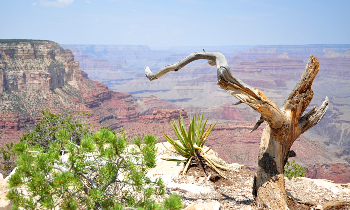 The South Rim of the canyon is the most popular among tourists and contains Grand Canyon National Park with a wide-sweeping outlook area and several walking trails. The park is open year-round with a current entrance fee of $35 US per private vehicle with up to 15 passengers.
The South Rim of the canyon is the most popular among tourists and contains Grand Canyon National Park with a wide-sweeping outlook area and several walking trails. The park is open year-round with a current entrance fee of $35 US per private vehicle with up to 15 passengers.
The visitor center offers sightseeing routes and schedules for the free shuttle buses that operate in the park, as well as information on excursions and activities in the area including plane and helicopter tours. There is also a convenient market plaza for souvenirs and Native American handcrafts, and an IMAX theater for a stunning film that gives tourists a bird’s eye view of what it’s like to soar above the canyon.
The Skywalk
 One of the most popular tourist attractions on the west rim of the Canyon is the Skywalk located at Eagle Point. This is a horseshoe-shaped transparent glass bridge that extends 70 feet over the rim of the canyon and allows visitors unique views of the gorge 4000 feet below. However, ALL personal belongings including cell phones, cameras, water bottles, purses, and backpacks must be stored in a free locker before entering the bridge wearing protective booties that won’t scratch the glass.
One of the most popular tourist attractions on the west rim of the Canyon is the Skywalk located at Eagle Point. This is a horseshoe-shaped transparent glass bridge that extends 70 feet over the rim of the canyon and allows visitors unique views of the gorge 4000 feet below. However, ALL personal belongings including cell phones, cameras, water bottles, purses, and backpacks must be stored in a free locker before entering the bridge wearing protective booties that won’t scratch the glass.
Built by the Hualapai tribe, the Skywalk attraction features an authentic Native American village on site that tourists can explore, as well as a gift shop for souvenirs and handcrafts.
Mule Rides
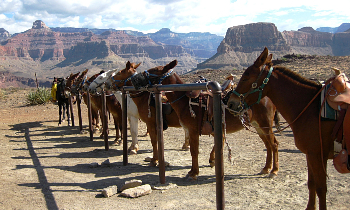 A traditional mule ride into the canyon is available at both the north and south rims. Different trails and ride types are available, including a venture deep into the canyon for an overnight excursion, or a ride along the rim for spectacular views.
A traditional mule ride into the canyon is available at both the north and south rims. Different trails and ride types are available, including a venture deep into the canyon for an overnight excursion, or a ride along the rim for spectacular views.
There are several tour operators in the region that cater to this type of tour, all of which have age and weight restrictions so be sure to read websites thoroughly before booking. This activity is extremely popular and books up quickly so several operators recommend booking as far as 12-15 months in advance.
Rafting Tours
 Beyond the rock layers of the canyon is a treasure trove of waterfalls, and unique rock formations that can only be accessed via the Colorado River. There’s also the man-made water body of Lake Powell to see. So rafting tours provide a memorable adventure as well as a much different perspective for viewing the canyon.
Beyond the rock layers of the canyon is a treasure trove of waterfalls, and unique rock formations that can only be accessed via the Colorado River. There’s also the man-made water body of Lake Powell to see. So rafting tours provide a memorable adventure as well as a much different perspective for viewing the canyon.
Tour operators in the region offer the adrenaline rush of whitewater rafting or a slower smooth water trip. Both are unforgettable but be prepared for an all-day adventure that does not come cheap.
Rainbow Bridge
 The eastern rim offers a much different view of the canyon with a lot more emphasis on the Colorado River. More importantly, it’s located on sacred Navajo tribal lands and provides several spectacular points of interest accessible only by boat. The most popular is the Rainbow Bridge, which is one of the largest natural bridges in the world standing over 290 feet tall and spanning 270 feet in width.
The eastern rim offers a much different view of the canyon with a lot more emphasis on the Colorado River. More importantly, it’s located on sacred Navajo tribal lands and provides several spectacular points of interest accessible only by boat. The most popular is the Rainbow Bridge, which is one of the largest natural bridges in the world standing over 290 feet tall and spanning 270 feet in width.
Natives believe this sandstone arc is responsible for creating clouds, rainbows, and rain in the desert. Consider booking with a tour company to see Rainbow Bridge, along with the Navajo Bridge, and the Little Colorado River Tribal Park.
Bearizona Wildlife Park
 Located off historic Route 66, approximately an hour from Grand Canyon National Park, travelers will find sixty acres of fun dedicated to the wildlife found in the region. Bearizona allows tourists to take a scenic drive through the parkland to view indigenous animals roaming free in their natural habitat of pine forests and canyon formations. This includes burrows, black bears, longhorn sheep, bison, wolves, and bobcats. Additionally, the park contains a walkthrough trail of exhibits and live shows featuring birds of prey. This attraction is popular with all ages. Visit the Bearizona website for ticket pricing and to plan your visit.
Located off historic Route 66, approximately an hour from Grand Canyon National Park, travelers will find sixty acres of fun dedicated to the wildlife found in the region. Bearizona allows tourists to take a scenic drive through the parkland to view indigenous animals roaming free in their natural habitat of pine forests and canyon formations. This includes burrows, black bears, longhorn sheep, bison, wolves, and bobcats. Additionally, the park contains a walkthrough trail of exhibits and live shows featuring birds of prey. This attraction is popular with all ages. Visit the Bearizona website for ticket pricing and to plan your visit.
Antelope Canyon
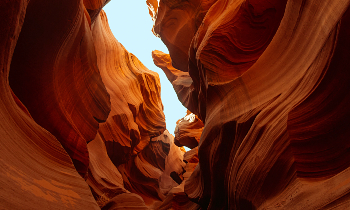 Located approximately 130 miles from Grand Canyon’s North Rim, within Lake Powell Navajo Tribal Park, visitors will discover this gorgeous sandstone formation known as a slot canyon. The twisting tunnels resemble a cave; however, there is no ceiling. Therefore, sunlight streams throughout and creates the illusion of the red and orange sandstone morphing and shifting depending on the angle of light.
Located approximately 130 miles from Grand Canyon’s North Rim, within Lake Powell Navajo Tribal Park, visitors will discover this gorgeous sandstone formation known as a slot canyon. The twisting tunnels resemble a cave; however, there is no ceiling. Therefore, sunlight streams throughout and creates the illusion of the red and orange sandstone morphing and shifting depending on the angle of light.
Antelope Canyon is a popular stop for many tourists who don’t want to miss the unique geological structure. It can be explored on foot with a guided tour.
Havasu Falls
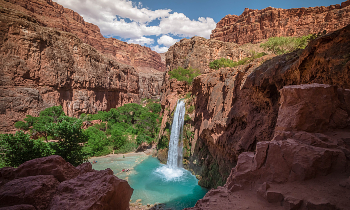 A beautiful desert oasis awaits on the Havasupai Indian Reservation, just south of the national park. It’s here that visitors will find gorgeous cascading falls and turquoise pools set against a red rock backdrop. The area is perfect for swimming in the hot summer month and is a picture takers paradise.
A beautiful desert oasis awaits on the Havasupai Indian Reservation, just south of the national park. It’s here that visitors will find gorgeous cascading falls and turquoise pools set against a red rock backdrop. The area is perfect for swimming in the hot summer month and is a picture takers paradise.
But note that Havasu Falls are in a remote area, and a visit is not something that can be undertaken last minute, nor will it entail just a few hours. It is an overnight commitment. A permit is required from the Havasupai Tribe, and reservations are needed for a camping spot or at the no-frills lodge. Essentials include plenty of water, food, and gear starting with good hiking shoes, a tent, a sleeping bag, a bathing suit, and water shoes. With a starting point of Hualapai Hilltop, it is a difficult 6-hour hike to the falls with no facilities. But in the end, the stunning views and memories are worth it.
Grand Canyon Railroad
 This historic train transports passengers between Williams and the South Rim’s Grand Canyon Depot. Along the way, the wide variety of beautiful landscapes is a must-see – from meadows and pine forests to canyons. Train guides provide informative and entertaining commentary about landscapes, landmarks, and the history of the railroad.
This historic train transports passengers between Williams and the South Rim’s Grand Canyon Depot. Along the way, the wide variety of beautiful landscapes is a must-see – from meadows and pine forests to canyons. Train guides provide informative and entertaining commentary about landscapes, landmarks, and the history of the railroad.
The train departs daily from Williams at 9:30 a.m. and arrives at Grand Canyon Village at approximately 11:45 a.m. The return trip departs the village at 3:30 p.m. and arrives back at Williams at approximately 5:45 p.m. The train depot includes a gift shop and a Wild West-themed show for visitors. For ticket pricing and seat class information, visit the Grand Canyon Railway website HERE.
Hiking
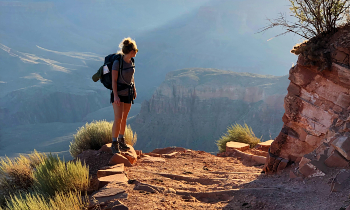 The Grand Canyon offers hikers an exceptional experience with nature, with five of the world’s seven life zones and three of the four types of deserts found in North America. This allows hikers to encounter several ecosystems and diverse flora and fauna all within one hike.
The Grand Canyon offers hikers an exceptional experience with nature, with five of the world’s seven life zones and three of the four types of deserts found in North America. This allows hikers to encounter several ecosystems and diverse flora and fauna all within one hike.
Loaded with options, the canyon provides several different hiking trails, duration times, and levels of difficulty. Some of the most popular include Bright Angel Trailhead, South Kaibab Trail to Cedar Ridge, North Kaibab Trail to Roaring Springs, Rim Trail, and Cape Royal Trail.
Guided hikes can take place over a period of days, and some can involve a mule ride or rafting trips at some point. If you’re not an experienced and appropriately fit hiker, a guide is the best option because the canyon presents a series of unique challenges that include severe temperature changes, difficult terrain, safety issues, and a lack of cell service.
Photo Credits:
Lead – by Jura on Unsplash
Grand Canyon National Park – by Angi12345 on Pixabay
Skywalk – by Justin Wang on Unsplash
Mule Ride – by Fezzywig on Pixabay
Whitewater Rafting – by MJ Thomas on Pixabay
Rainbow Bridge – by Tom Gainor on Unsplash
Bearizona – by Nick Monge on Unsplash
Antelope Canyon – by Tom Morbey on Unsplash
Havasu Falls – by Jan Kronies on Unsplash
Grand Canyon Railroad – by Psyco72 on Pixabay
Hiking – by Jacob Jolibois on Unsplash


